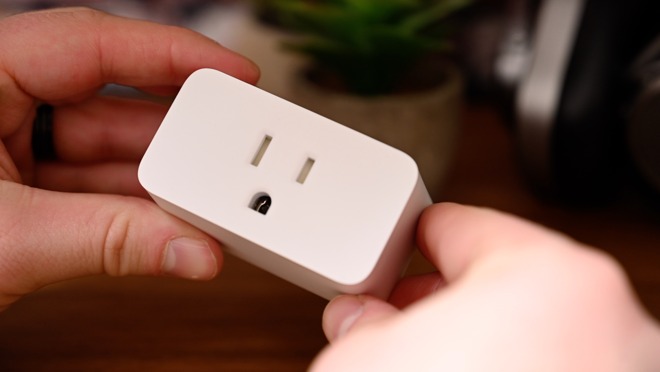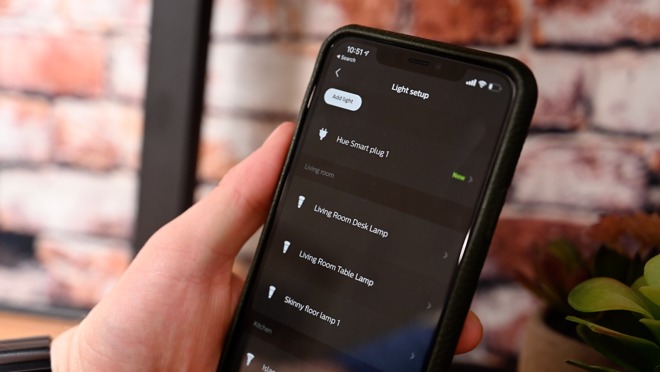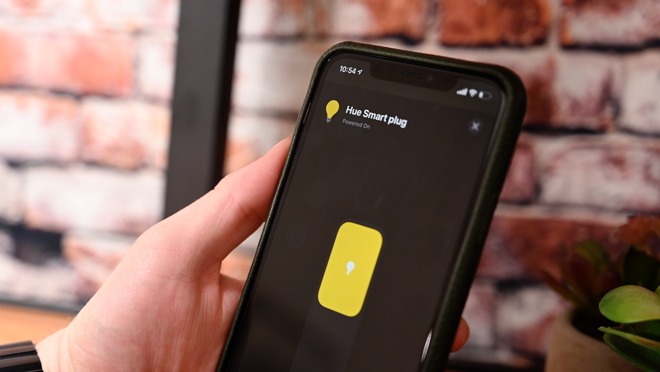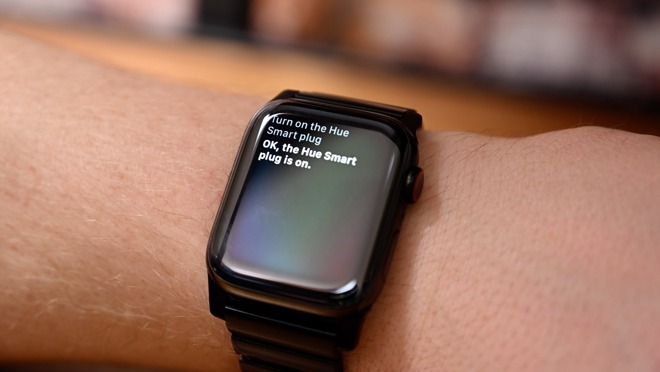Review: Hue Smart Plug is another capable HomeKit-enabled outlet
The Hue Smart Plug is an expansion of the Hue lineup from smart bulbs into controlling lamps, one that brings the HomeKit-compatible range closer to becoming a whole smart home solution.

Philips Hue Smart Plug
Smart bulbs and smart outlets are arguably interchangeable as the most popular smart home products on the market. With so many already available, why do we need yet another option to consider? The Hue Smart Plug may not do anything truly revolutionary, but it is an important product to the Hue lineup.
Hue doesn't deviate from that here. It does just the same in its own way.
The plug itself is compact and unassuming with a matte white exterior. There is a single button located to the left side to toggle the light on and off manually if you need it. It is also used for resetting the device should you ever want to remove it from your home or if it is acting up.
On top of the plug is a small sticker, reminding users that this is intended solely for lights -- not heavy appliances. Hue is a lighting line after all.
To set up the plug, it just needs plugged into any outlet, and configured from one of two Hue apps. Users who want simple and to control locally in the home may choose the (newer) Hue Bluetooth app. However, to get the most out of it, you must use the standard Hue app and the Hue Bridge.
With the Hue Bridge, you unlock the ability to tie the outlet into HomeKit as well as all of the automation routines and accessories of the Hue ecosystem. That's what we are going to walk through here.

Setup of the Hue Smart Plug
We plugged the device in, ventured into our Hue app, tapped "add accessory" from Settings, and only a few moments later the Hue Smart Plug 1 appeared.
You can then change the name or the icon to be more representative of what you will be connecting. You can also go into room and zone setup to assign this device to an explicit location. Then a quick sync of the HomeKit & Siri settings and you are ready to rock.

The Hue Smart Plug in Apple's HomeKit Home app
When you venture outside the Hue apps is where a smart plug such as this gets truly powerful. In the Home app, you can tie it into any other HomeKit accessories -- be it other smart outlets, smart bulbs, fans, occupancy sensors, security systems, and much more. You can create automation rules for whenever someone comes or goes, based on a time of day, when a sensor detects something, or when an accessory is controlled. So many options open up.

Hue Smart Plug in Apple's Home app
One of our favorite uses is tying accessories to NFC tags. NFC tags are inexpensive (or you can re-use ones you may even have lying around). Then whenever you tap your phone against an NFC tag hidden on the underside of your desk the room's lights turn on. (Learn how to do so here.)
Siri is an option as well -- on your iPhone, iPad, Mac, Apple TV, HomePod, or Apple Watch. You can ask if the switch is on or off as well as control it.
The Hue Smart Plug mostly exists to fill that hole in Hue's lineup -- when you have a light that you can't or don't wish to replace the bulb with a Hue version. The lamp could take a bulb style Hue doesn't yet make. It could have a great retro bulb with a stylized filament you want to show off. Or it could be a novelty light that doesn't use a normal bulb.
Whatever the case, there are times when a smart outlet is necessary.

Using Siri on Apple Watch to control the Philips Hue Smart Plug
We like how the Hue Smart Plug has the option to work solely through Bluetooth or through the Hue Bridge which makes it useful for even those who don't have a bridge as-is.
It does lack some nifty features we've seen in the past such as a customizable night light or energy consumption monitoring but when it comes to just being a smart outlet, Hue has nailed it.
Pros

Philips Hue Smart Plug
Smart bulbs and smart outlets are arguably interchangeable as the most popular smart home products on the market. With so many already available, why do we need yet another option to consider? The Hue Smart Plug may not do anything truly revolutionary, but it is an important product to the Hue lineup.
Hue Smart Plug basics
Everyone already likely knows the practical applications of a smart outlet such as this. Connect anything to the Hue Smart Plug and then control it from your phone -- no need to reach under the lampshade for a knob. Add in some automation rules, and it can even turn itself on and off when necessary.Hue doesn't deviate from that here. It does just the same in its own way.
The plug itself is compact and unassuming with a matte white exterior. There is a single button located to the left side to toggle the light on and off manually if you need it. It is also used for resetting the device should you ever want to remove it from your home or if it is acting up.
On top of the plug is a small sticker, reminding users that this is intended solely for lights -- not heavy appliances. Hue is a lighting line after all.
To set up the plug, it just needs plugged into any outlet, and configured from one of two Hue apps. Users who want simple and to control locally in the home may choose the (newer) Hue Bluetooth app. However, to get the most out of it, you must use the standard Hue app and the Hue Bridge.
With the Hue Bridge, you unlock the ability to tie the outlet into HomeKit as well as all of the automation routines and accessories of the Hue ecosystem. That's what we are going to walk through here.

Setup of the Hue Smart Plug
We plugged the device in, ventured into our Hue app, tapped "add accessory" from Settings, and only a few moments later the Hue Smart Plug 1 appeared.
You can then change the name or the icon to be more representative of what you will be connecting. You can also go into room and zone setup to assign this device to an explicit location. Then a quick sync of the HomeKit & Siri settings and you are ready to rock.
Using the Smart Plug
To use the Hue Smart Plug, it can simply be toggled on or off from within its room in the Hue app. To level up, you can create routines that automate the outlet. Perhaps a wakeup routine that turns the light on in the morning. Or toggle it from a Hue button you have on the wall. Or just turn on and off at certain times of the day.
The Hue Smart Plug in Apple's HomeKit Home app
When you venture outside the Hue apps is where a smart plug such as this gets truly powerful. In the Home app, you can tie it into any other HomeKit accessories -- be it other smart outlets, smart bulbs, fans, occupancy sensors, security systems, and much more. You can create automation rules for whenever someone comes or goes, based on a time of day, when a sensor detects something, or when an accessory is controlled. So many options open up.

Hue Smart Plug in Apple's Home app
One of our favorite uses is tying accessories to NFC tags. NFC tags are inexpensive (or you can re-use ones you may even have lying around). Then whenever you tap your phone against an NFC tag hidden on the underside of your desk the room's lights turn on. (Learn how to do so here.)
Siri is an option as well -- on your iPhone, iPad, Mac, Apple TV, HomePod, or Apple Watch. You can ask if the switch is on or off as well as control it.
Should you pick one up?
It is quite difficult to dictate which smart plug is absolutely the best or which one we would unanimously hands-down recommend. What we can say, is that the Hue Smart Plug worked very well. It is reliable and fits in very well if you already have an existing Hue setup.The Hue Smart Plug mostly exists to fill that hole in Hue's lineup -- when you have a light that you can't or don't wish to replace the bulb with a Hue version. The lamp could take a bulb style Hue doesn't yet make. It could have a great retro bulb with a stylized filament you want to show off. Or it could be a novelty light that doesn't use a normal bulb.
Whatever the case, there are times when a smart outlet is necessary.

Using Siri on Apple Watch to control the Philips Hue Smart Plug
We like how the Hue Smart Plug has the option to work solely through Bluetooth or through the Hue Bridge which makes it useful for even those who don't have a bridge as-is.
It does lack some nifty features we've seen in the past such as a customizable night light or energy consumption monitoring but when it comes to just being a smart outlet, Hue has nailed it.
Pros
- Compact design allows two plugs for a set of wall outlets
- Clean finish matches many homes
- Works very reliably
- Works either through Bluetooth or Hue Bridge
- Easy setup and use
- HomeKit support
- Requires bridge for best features
- No energy consumption monitoring


Comments
The Hue API is outstanding. It's open and well documented.
https://store.idevicesinc.com/cart.php?suggest=0c80640c-1a0b-491b-8690-ae170d6cf8f6
On the plus side, unlike iDevices 15A switches, these (and most others) do not contain an independent night-light which must be managed in HomeKit and complicate use of the switch function.